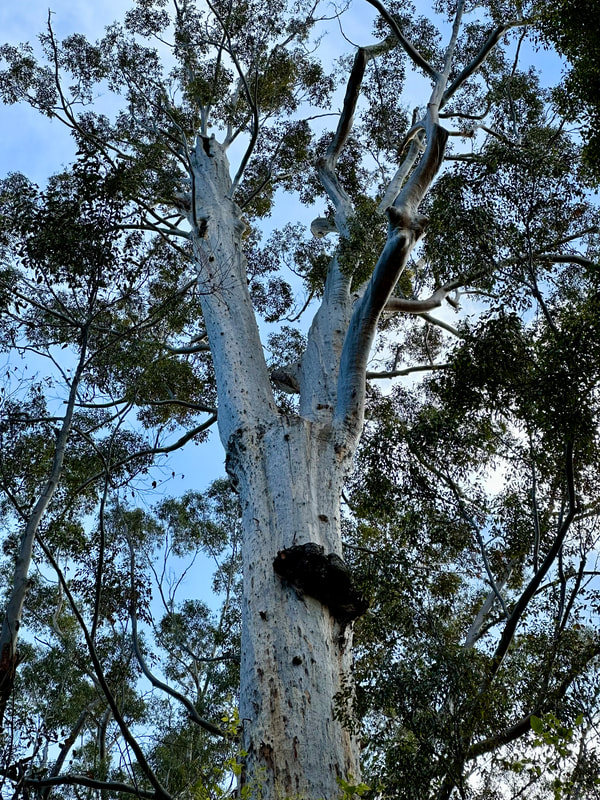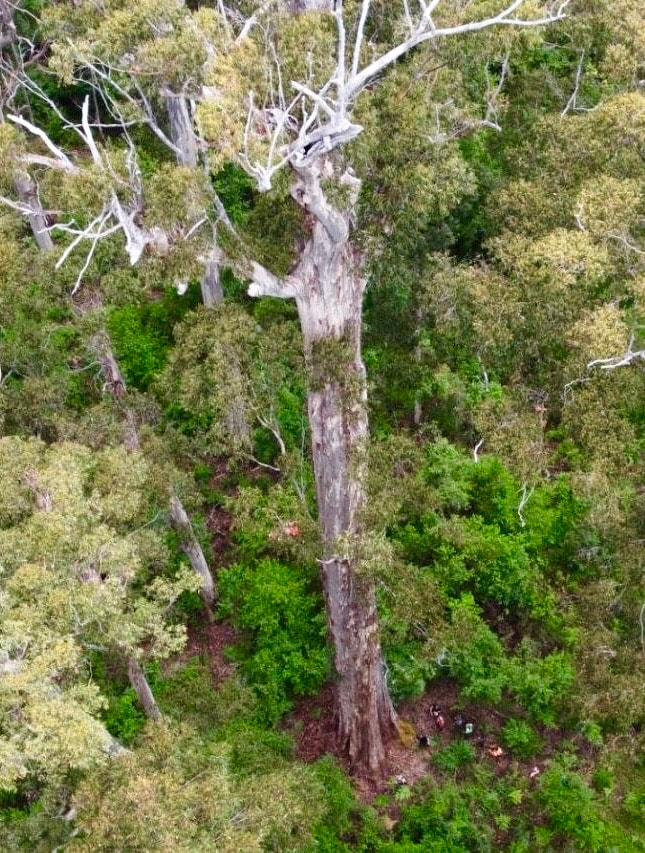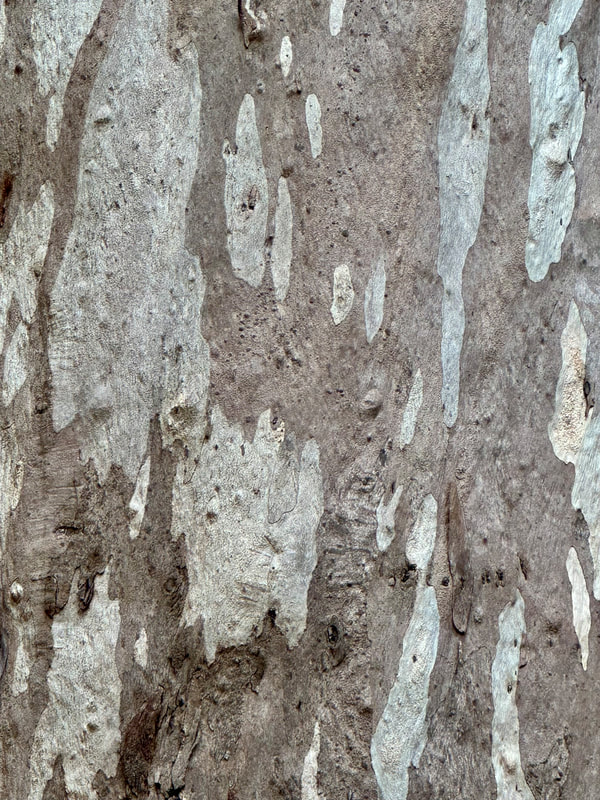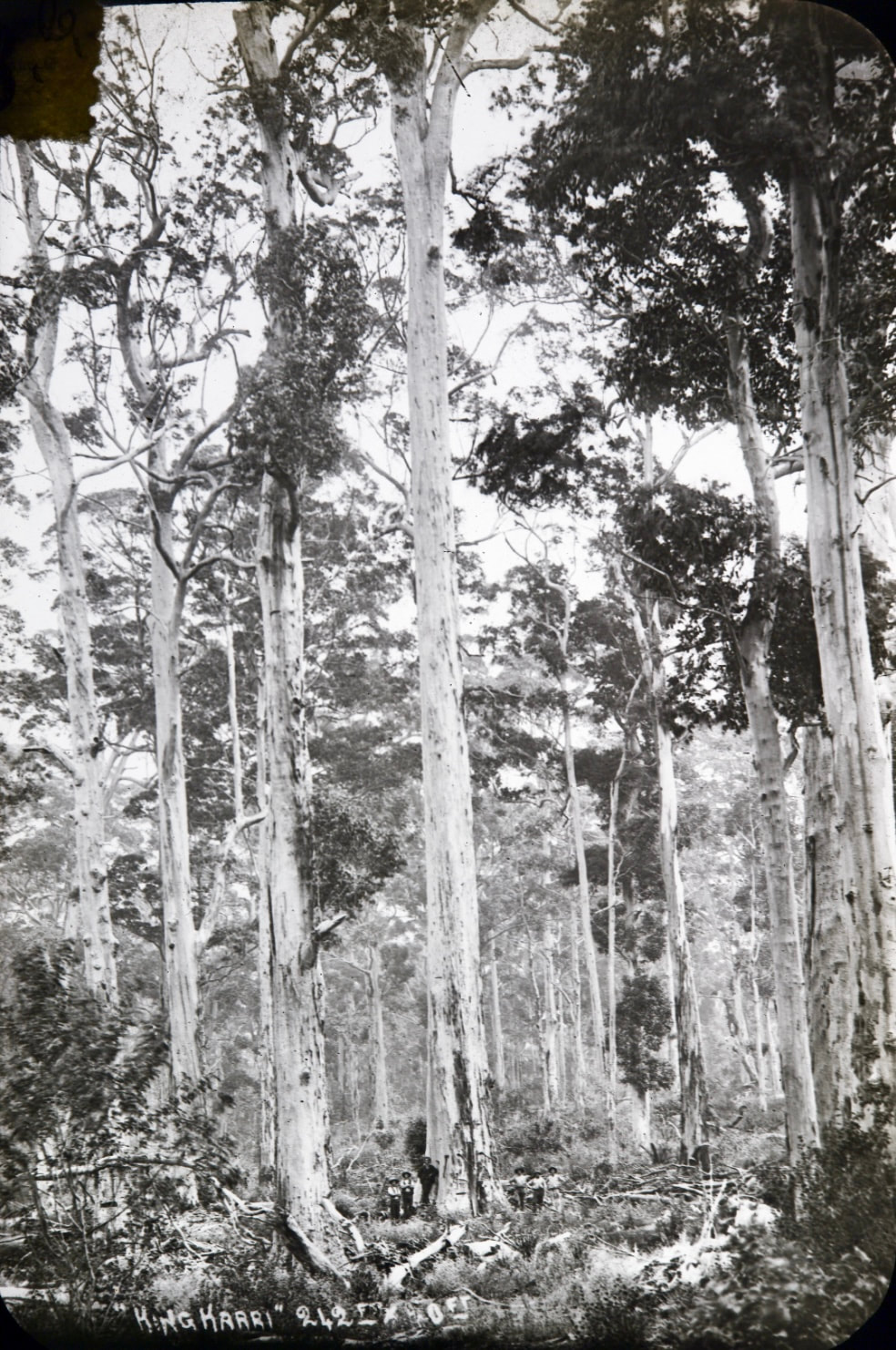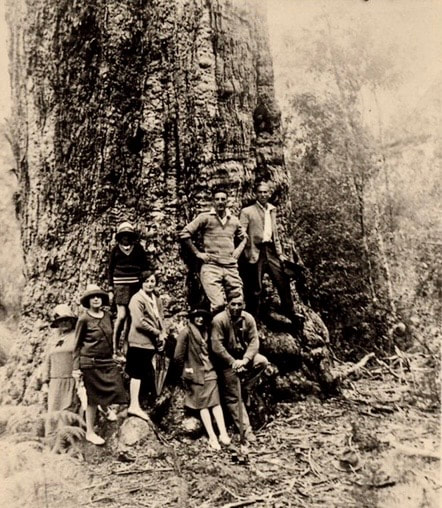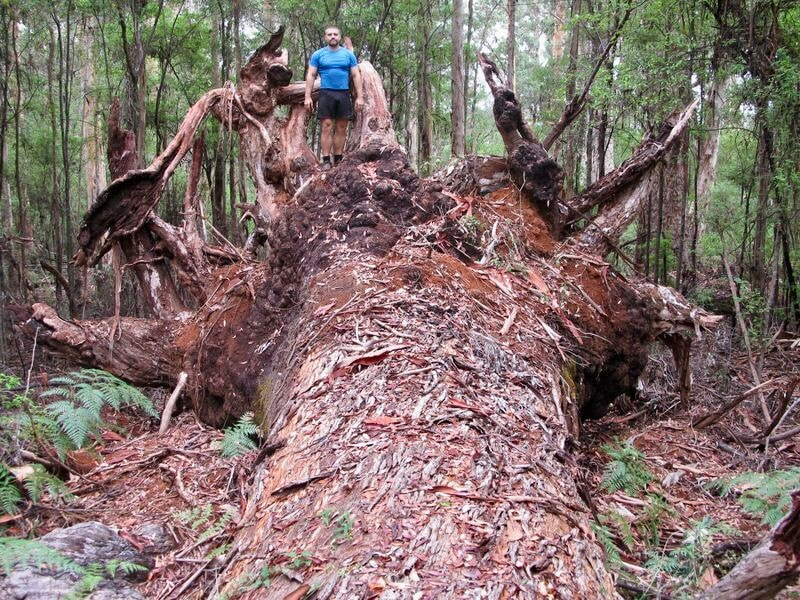Karri (Eucalyptus diversicolor) is a beautiful, tall forest giant found in the Warren ecoregion near the southern coast of Western Australia. This region is named after the Warren River and created to encompass the karri forest although a few remnant populations exist just outside the region. The area at around 8500 km² is recognised internationally as an ecoregion, high in natural biodiversity. The karri forests are estimated to have covered an area of around 2000 km² within this region once. Estimates of old-growth forest remaining is about 400 km², the largest stand being Warren National Park established in 1977 at approximately 30 km². This park is very special and lucky. When walking in from the main carpark, the main walking track for a short section is unnecessarily wide, a very unusual feature for a hiking trail. While walking the track with a friend, we both came to the conclusion that it was going to be a logging road. We think it was spared and preserved simply due to its incredible beauty. Karri are unmistakable when mature, the only giant gum tree in WA with smooth bark except around the rough base. Their huge creamy grey trunks reaching up to the sky and when they are shedding bark other colours such as shades of yellow and pink are visible. Karri also have fewer but larger limbs than their eastern state Eucalyptus cousins with the Hawke, Tyrant and others having multiple limbs around 1 metre in diameter.
Karri was extensively logged in the past for the high quality timber and the high quantity of wood available per tree. Old-growth karri is still logged like jarrah despite a public perception that this practice was stopped years ago. Indeed in 2012 karri collected from a timber mill was carbon-dated to nearly 600 years old, double the age karri was thought to reach. This finding was disputed by the mill manager but the head tester reaffirmed the findings. This prompted 27 environmental groups to protest for complete protection of the karri forest. This wood was destined for woodchips and paper production. In the past, karri timber was used for heavy construction purposes. Despite most of the karri forest being logged and cleared for pasture in the past, it grows back well not needing seeding, unlike most Eucalyptus. There are several abandoned farms from the past now covered with sizable karri, named as hundred year old forests. Large areas once logged have been protected for conservation and feature heavily in tourism brochures. The town of Pemberton is an excellent place to begin your karri adventures as it is ideally situated near national parks and recreation sites.
Some of the eight original fire lookout trees built between 1937 and 1952 have now become tourist attractions. These were early warning systems, designed to assist in the quick response to a bushfire, complete with phone line! The famous Gloucester Tree located at Pemberton was constructed in 1947 and at 61 m tall is the only original tree left which you can still climb with others now decommissioned. Since 2024, a rope climbing and zip line tourist adventure course with has been constructed metres from the Gloucester Tree. Called Aerial Adventure Pemberton, my son and myself can attest to its unique karri forest experience, with easy to challenging levels for all ages. The other climbing tree named Dave Evans Bicentennial Tree is found in the Warren National Park was built for tourists celebrating Australia's bicentennial in 1988. At 75 m tall to the top, it is the worlds tallest lookout tree. Both the Gloucester and Dave Evans Bicentennial Tree have steel pegs and lookout cages which are checked regularly for weaknesses. Though they are large mature karri, they are about half as big as the biggest karri but around the same height. A windy day at the top of either can be an uncomfortable but memorable experience if you're not used to being blown around uncontrollably up a massive tree!
Karri is often mentioned in texts as being the second tallest Eucalyptus after mountain ash (Eucalyptus regnans). Although I would like to agree with this statement this is not the case. There are a few other Eucalyptus species in Tasmania which exceed karri reaching to 90 m measured by laser. This number is actually the figure most texts print as the height karri reach to but it has no reference source, credible or otherwise. Karri is actually about the sixth tallest Eucalyptus although probably the second tallest on mainland Australia after the mountain ash (Eucalytpus regnans) of Victoria. The tallest mountain ash (Eucalyptus regnans) in Tasmania, named Centurion reaches 100.5 m tall, I know because I’ve measured it with a surprised Brett and ABC film crew confirming this. Brett and myself went to check its health and other giants after the 2019 Tasmanian fires. Brett had previously climbed Centurion and accurately tape dropped a height of just less than 100 m, it appeared to have grown, but we think a limb break near the top actually straightened the top limb!
Some of the eight original fire lookout trees built between 1937 and 1952 have now become tourist attractions. These were early warning systems, designed to assist in the quick response to a bushfire, complete with phone line! The famous Gloucester Tree located at Pemberton was constructed in 1947 and at 61 m tall is the only original tree left which you can still climb with others now decommissioned. Since 2024, a rope climbing and zip line tourist adventure course with has been constructed metres from the Gloucester Tree. Called Aerial Adventure Pemberton, my son and myself can attest to its unique karri forest experience, with easy to challenging levels for all ages. The other climbing tree named Dave Evans Bicentennial Tree is found in the Warren National Park was built for tourists celebrating Australia's bicentennial in 1988. At 75 m tall to the top, it is the worlds tallest lookout tree. Both the Gloucester and Dave Evans Bicentennial Tree have steel pegs and lookout cages which are checked regularly for weaknesses. Though they are large mature karri, they are about half as big as the biggest karri but around the same height. A windy day at the top of either can be an uncomfortable but memorable experience if you're not used to being blown around uncontrollably up a massive tree!
Karri is often mentioned in texts as being the second tallest Eucalyptus after mountain ash (Eucalyptus regnans). Although I would like to agree with this statement this is not the case. There are a few other Eucalyptus species in Tasmania which exceed karri reaching to 90 m measured by laser. This number is actually the figure most texts print as the height karri reach to but it has no reference source, credible or otherwise. Karri is actually about the sixth tallest Eucalyptus although probably the second tallest on mainland Australia after the mountain ash (Eucalytpus regnans) of Victoria. The tallest mountain ash (Eucalyptus regnans) in Tasmania, named Centurion reaches 100.5 m tall, I know because I’ve measured it with a surprised Brett and ABC film crew confirming this. Brett and myself went to check its health and other giants after the 2019 Tasmanian fires. Brett had previously climbed Centurion and accurately tape dropped a height of just less than 100 m, it appeared to have grown, but we think a limb break near the top actually straightened the top limb!
The image above is typical of karri bark. With a mottled pattern of smooth, hard bark, shades of creamy white to grey are usual. When shedding bark, colours of yellow, orange, and even pink are seen. In contrast to the bright green karri understory, the white giant karri trunks are an awe inspiring sight. The karri tree grows in a soil classified as karri loam which is considered excellent for grazing. Most of the karri loam content is bark that has shedded from trees, decaying over thousands of years. Annual rainfall is 900-1300 mm. The karri forest has a dense understory with 2000 plant species growing under its canopy, as well as an abundance of animals, insect life and 150 bird species. I found a wedge-tailed eagle (Aquila adax) primary feather once measuring a giant karri in the Hawke Grove, an incredible patch of old growth forest I named for the Hawke Tree. I took it back home to the delight of my family and named the karri I was measuring the Eagle Tree. On that same trip I was measuring a tree I named the Moss Karri due to it’s base but I was being distracted by a regular shuddering sound. Every five minutes I would hear grinding sounds followed by a pause then the big shuddering would occur. I reasoned that this may have been going on for weeks or months so continued with my measuring. After only a few cycles of this a tremendous rolling crash filled the air. The crash lasted around ten seconds and was overwhelmingly loud. I couldn’t see the falling giant despite the deafening sound. I continued with my measuring then set off in the direction I thought it occurred. I didn’t find the downed karri but I returned a few months later and found a huge downed karri I named the Fallen Beast. I believe it was probably the tree which fell that day. I can also confirm that if a tree does fall in a forest, you can hear it, and it’s loud! Many people admire the majesty of giant karri trees lining the highways of the South West, certainly adding to their road trip experience. I myself am always excited whenever I enter 'karri country', knowing that a new adventure is just around the bend.
The moment I received my dendrometer, laser and GPS the first thing I did was to head south to Larkin Road and the Hawke Grove to measure the Hawke Tree and other large karri nearby. This giant was found in the late 1970s and had a track and large signpost built for what Parks and Wildlife believed was the biggest karri. The signpost had long been removed but the old trail was visible but soon it too disappeared but I found what I thought was the Hawke Tree. I hadn't been there for 5 years and the track was totally overgrown for the final kilometre so I was bush bashing carry my heavy, bulky equipment. After re checking older pictures of the Hawke Tree I realised I had found a giant I remembered off the original track years earlier. My tree hunting friend Brett who had also spied this giant in the 1990s on route to the Hawke Tree confirmed my error with his old photos! Eventually I found the Hawke Tree and to my surprise the new giant beat it out for size. My wife Brigitte named it The Tyrant as it was not a benevolent ruler, refusing to give up its secrets, although to be fair it was all worth it!
Historical Accounts
There is a report from 1921 of a fallen karri measuring 100 m long, but I don't consider this credible, no photos with only a verbal account and over 20 metres taller than any karri currently known. An 87 m fallen karri in Pemberton in 1901 has been reported in various government documents might be accurate, although again, no other information about this tree exists. Many publications list the karri as reaching 90 m tall, and I suspect the Pemberton tree is the source of this figure, but rounded up to 90 m. Stewart's Karri near Manjimup was one of the potential fire lookout trees found by Don Stewart in the 1940s and considered the tallest karri. Not selected as a fire lookout tree due to being located in a valley it was recorded at 85 m tall pre laser technology, which has low accuracy. It has been known for years as the tallest karri but was never signposted and local or official knowledge was needed to locate it. Brett found it in 2000 and recorded 80.5 m with his laser. I finally located it in 2020 after several failed attempts over the decades! The map officials gave me was out of date, with new roads built totally changing the landscape. I recognised its base and limb structure from earlier images of it to confirm its identity. Unfortunately it has lost height due to crown damage and was exactly 70 m tall, 2.5 m DBH and about 100 m³ in volume. It has since been highlighted in a campaign to protect the area from a proposed dam as the tallest karri at 83 m tall despite its obvious damage years earlier with a dead crown. The biggest trees are usually not the tallest as younger trees have less crown damage and in the Stewart’s Karri protected in a valley. I have measured three karri that were listed as over 80 m tall, pre laser technology. They were all around 75 metres, and I suspect they were never 80 m as they all still had intact crowns. I've probably measured around 100 karri I selected due their height and most reach to, but rarely exceed 70 m. If I was asked, I would say karri reach to 70 m with a maximum of 80 m in a few cases. There is no reliable evidence for greater height. Having said that, I do believe some of the current giants such as Channybearup Karri, Big Karri and King Karri could have easily reached 80 m once, the Riverside Karri being the tallest currently at 77 m to its dead top was definitely 80 m once.
There is surprisingly few historic karri trees recorded and photographed. Most past images of karri understandably involve human related activities showing how downed karri were transported to the sawmill.
The biggest historic karri I have come across is a well known picture dated from 1901 in Karridale, an area now almost devoid of karri. Named King Karri, the little research I've been able to find is that the tree was protected by M C Davies, the timber merchant of the area. Unfortunately the tree succumbed after a severe storm in July 1900, the photo produced after it fell. A postcard was also sold stating the trees dimensions as 73.8 m tall, and 3.9 m in DBH. The original image displays the tree from some distance showing the main trunk terminating with three large limbs emerging around 40 m where it looks around 1.2 m in diameter. Some forced perspective may be involved here making my estimations a little off, but I've roughly measured the trunk at 160 m³, nearly the same size as The Tyrant and Hawke Tree. Limbs are more of a guess but the three huge limbs are around .8 m in width could have been up to 10 m³ each.
The moment I received my dendrometer, laser and GPS the first thing I did was to head south to Larkin Road and the Hawke Grove to measure the Hawke Tree and other large karri nearby. This giant was found in the late 1970s and had a track and large signpost built for what Parks and Wildlife believed was the biggest karri. The signpost had long been removed but the old trail was visible but soon it too disappeared but I found what I thought was the Hawke Tree. I hadn't been there for 5 years and the track was totally overgrown for the final kilometre so I was bush bashing carry my heavy, bulky equipment. After re checking older pictures of the Hawke Tree I realised I had found a giant I remembered off the original track years earlier. My tree hunting friend Brett who had also spied this giant in the 1990s on route to the Hawke Tree confirmed my error with his old photos! Eventually I found the Hawke Tree and to my surprise the new giant beat it out for size. My wife Brigitte named it The Tyrant as it was not a benevolent ruler, refusing to give up its secrets, although to be fair it was all worth it!
Historical Accounts
There is a report from 1921 of a fallen karri measuring 100 m long, but I don't consider this credible, no photos with only a verbal account and over 20 metres taller than any karri currently known. An 87 m fallen karri in Pemberton in 1901 has been reported in various government documents might be accurate, although again, no other information about this tree exists. Many publications list the karri as reaching 90 m tall, and I suspect the Pemberton tree is the source of this figure, but rounded up to 90 m. Stewart's Karri near Manjimup was one of the potential fire lookout trees found by Don Stewart in the 1940s and considered the tallest karri. Not selected as a fire lookout tree due to being located in a valley it was recorded at 85 m tall pre laser technology, which has low accuracy. It has been known for years as the tallest karri but was never signposted and local or official knowledge was needed to locate it. Brett found it in 2000 and recorded 80.5 m with his laser. I finally located it in 2020 after several failed attempts over the decades! The map officials gave me was out of date, with new roads built totally changing the landscape. I recognised its base and limb structure from earlier images of it to confirm its identity. Unfortunately it has lost height due to crown damage and was exactly 70 m tall, 2.5 m DBH and about 100 m³ in volume. It has since been highlighted in a campaign to protect the area from a proposed dam as the tallest karri at 83 m tall despite its obvious damage years earlier with a dead crown. The biggest trees are usually not the tallest as younger trees have less crown damage and in the Stewart’s Karri protected in a valley. I have measured three karri that were listed as over 80 m tall, pre laser technology. They were all around 75 metres, and I suspect they were never 80 m as they all still had intact crowns. I've probably measured around 100 karri I selected due their height and most reach to, but rarely exceed 70 m. If I was asked, I would say karri reach to 70 m with a maximum of 80 m in a few cases. There is no reliable evidence for greater height. Having said that, I do believe some of the current giants such as Channybearup Karri, Big Karri and King Karri could have easily reached 80 m once, the Riverside Karri being the tallest currently at 77 m to its dead top was definitely 80 m once.
There is surprisingly few historic karri trees recorded and photographed. Most past images of karri understandably involve human related activities showing how downed karri were transported to the sawmill.
The biggest historic karri I have come across is a well known picture dated from 1901 in Karridale, an area now almost devoid of karri. Named King Karri, the little research I've been able to find is that the tree was protected by M C Davies, the timber merchant of the area. Unfortunately the tree succumbed after a severe storm in July 1900, the photo produced after it fell. A postcard was also sold stating the trees dimensions as 73.8 m tall, and 3.9 m in DBH. The original image displays the tree from some distance showing the main trunk terminating with three large limbs emerging around 40 m where it looks around 1.2 m in diameter. Some forced perspective may be involved here making my estimations a little off, but I've roughly measured the trunk at 160 m³, nearly the same size as The Tyrant and Hawke Tree. Limbs are more of a guess but the three huge limbs are around .8 m in width could have been up to 10 m³ each.
The mighty King Karri from 1900, showing its full trunk to about 40 m. Notice the 6 men at the base. Total volume is estimated at around 190 m³. Image is dated from 1901 at Karridale and is reproduced with permission from the State Library of Western Australia.
The only other great old karri picture that I am aware of rivalling the current champs is from the Frankland River region, near Walpole, dated around the 1920s judging by the fashion. Named the Boxall Tree I recently learnt from Walpole resident and local historian David that it was a tourist attraction best visited from the Frankland River. The ferry service stopped probably around the great depression era and the tree was forgotten about, presumed to have fallen. In 1990 David and some friends dove into the forest to try to locate it and they succeeded, the tree was still alive. In 2020 he went on another trip to check its status and it was found to have fallen over recently, regrettably before I knew it had survived. The giant tree had lost its head by the time it was originally discovered so its true height will never be known. However at 5 m the tree was 3 m wide, and another photo I've found shows at 10 m it was still 2.5 m wide, in between in width of The Tyrant and Hawke tree! In fact, in the other photo it is described as a red tingle! Karri in this region are considerably shorter than their western cousins rarely over 50 m tall. It’s reasonable to assume the bole height was not as tall as the current champions which have 40 m bole heights. If I speculate it had a bole height of 30 m it would have been around 150 m³ of trunk volume with an estimated 20 m³ of limb volume for around 170 m³ of total volume. If it did indeed did have a greater bole height it could have easily reached to 200 m³ in total volume! Next time I’m in the region I’ll try to locate the fallen Boxall Tree and estimate its volume to see how it measured up.
The Boxall Tree from the 1920s, a Karri which only fell in the late 2010s was as wide as The Tyrant and Hawke Tree at 3.5 m in DBH. With an estimated ZG width of 4.5 m, it was 1-2 m narrower than those karri at its base but had little noticeable trunk taper and was likely at least 170 m³ in total volume. Image is reproduced with permission of the Walpole Historical Society.
This image of the Fallen Beast is from 2013 in the Hawke Grove. It was the giant karri I believe I heard fall to the ground while I was measuring the Moss Karri, at 147.2 m³ in total volume in 2013. However this 3.5 m DBH beast I estimate would have been around 200 m³ in total volume! Within 100 metres of The Tyrant, the Eagle and Hawke Tree are only a little further away, what a patch of karri forest this is!
